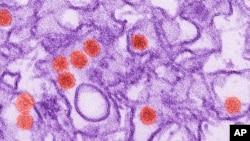The risk posed by the Zika virus to developing fetuses is likely far greater than current estimates suggest, a top U.S. health official said Thursday.
Microcephaly, a rare birth defect in which babies develop abnormally small heads, is one of many Zika-associated problems increasingly being seen in children born to mothers infected during pregnancy with the Zika virus.
Other birth defects include seizures, deafness, blindness and a range of neurological and developmental abnormalities.
Earlier this year, a U.S. analysis estimated the risk of microcephaly at 1 to 13 percent when a mother is infected with the virus during the first trimester of pregnancy.
That figure does not include the overall risk of birth defects, Dr. Anthony Fauci, director of the National Institute of Allergy and Infectious Diseases, said during a panel discussion on Zika.
“If you’re talking about any congenital defect, I think it’s going to be much higher than 13 percent,” he said. “I think we’re going to see something very disturbing.”
The panel was presented by Harvard T.H. Chan School of Public Health in collaboration with Reuters.
WHO declares emergency; Congress OKs funding
The World Health Organization declared a global health emergency over Zika’s link to microcephaly in February. The mosquito-borne virus has spread rapidly through the Americas, with Brazil hit hardest so far. On Wednesday, the U.S. Congress approved $1.1 billion to fund research and efforts to contain Zika.
Speaking on the same Zika panel Thursday, Dr. Marcia Castro, an associate professor of demography at Harvard, said physicians in Brazil are studying the initial wave of babies affected by Zika who are now reaching their first birthday.
In addition to seizures, agitation and frequent crying, these children also exhibit a severe type of reflux that prevents them from eating, she said, adding that it is unclear how long these children will live.
“Another study with mice shows Zika also affects the brain of an adult,” she said, potentially affecting long-term memory and depression.
Virus spreads in the Americas
As of Sept. 17, Brazil had confirmed 1,949 cases of microcephaly linked to Zika, mostly concentrated in the country’s northeast region. Another 3,030 cases are under investigation. In the United States, the virus has infected tens of thousands of people in Puerto Rico.
The spread of the virus in Miami, where a handful of locally transmitted cases emerged, has been limited through aggressive mosquito control.
“Puerto Rico is going through a terrible situation and we have to help them right now,” Fauci said.
With new Zika funding in hand, Fauci said the first priority will be to move forward clinical trials of five potential vaccines.









